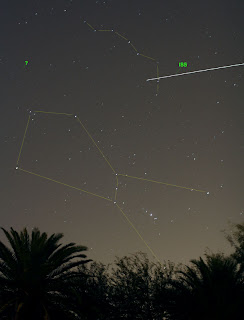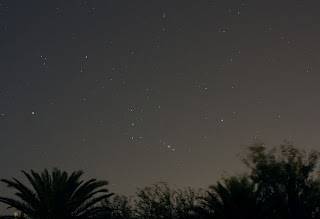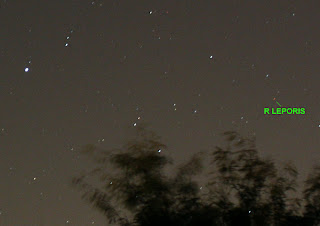 Orion is located right on the celestial equator, so can be seen virtually all over the world except the poles. It contains many bright stars, and with the 3 equally-spaced stars forming the belt stars, it makes for a striking appearance. Though the colors are washed out a bit from these exposures, if you check it out visually, see if you can detect a yellowish color in Betelgeuse, the left shoulder star, compared to the bluish Rigel, the right foot star. The color difference reflects the temperature difference of the stars' surface, Betelgeuse being about 3,500K and Rigel 11,000K (5,800 & 19,300F). If observing Orion with binoculars, especially from a dark sky, be sure to check out the hunter's "sword" hanging below his belt (lower right from the belt in these photos). The cloudy wisps visible is known as the Orion Nebula, and is a spectacular star formation area, visible in telescopes large or small.
Orion is located right on the celestial equator, so can be seen virtually all over the world except the poles. It contains many bright stars, and with the 3 equally-spaced stars forming the belt stars, it makes for a striking appearance. Though the colors are washed out a bit from these exposures, if you check it out visually, see if you can detect a yellowish color in Betelgeuse, the left shoulder star, compared to the bluish Rigel, the right foot star. The color difference reflects the temperature difference of the stars' surface, Betelgeuse being about 3,500K and Rigel 11,000K (5,800 & 19,300F). If observing Orion with binoculars, especially from a dark sky, be sure to check out the hunter's "sword" hanging below his belt (lower right from the belt in these photos). The cloudy wisps visible is known as the Orion Nebula, and is a spectacular star formation area, visible in telescopes large or small.Tonight I was thinking of a blog post about Orion, happened to check Heavens-Above and saw that the International Space Station (ISS) was making a good pass going through the constellation! So with a 10 minute warning, we ran outside and managed to capture the ISS pass with a 35mm lens and a 15 second exposure. Between this shot showing the ISS and a test shot a minute or two before, several satellites were captured, including a tumbler (varying in brightness) marked with a "?" in the first shot. As always, click on the exposures to see a full-size image.

 The other photo shows a horizontal format shot of the same field, but interestingly shows another item of interest. Skimming the Sky and Telescope website (a favorite magazine of mine) a few days ago, I noticed an entry that variable star R Leporis was nearing maximum and should be visible in binoculars or small telescope as a red star. Would it be visible in an exposure of just a few seconds? Sure enough, when cropped and blown up a little from the original 20 second exposure, it is visible as a red glow. Supposedly it is even more red when at minimum, but would also be virtually invisible from town... To discoverer, J.R.Hind, it appeared "like a drop of blood on a black field." With a 400+ day period, it might be worth trying to image it when it is fainter to see if it can get any redder.
The other photo shows a horizontal format shot of the same field, but interestingly shows another item of interest. Skimming the Sky and Telescope website (a favorite magazine of mine) a few days ago, I noticed an entry that variable star R Leporis was nearing maximum and should be visible in binoculars or small telescope as a red star. Would it be visible in an exposure of just a few seconds? Sure enough, when cropped and blown up a little from the original 20 second exposure, it is visible as a red glow. Supposedly it is even more red when at minimum, but would also be virtually invisible from town... To discoverer, J.R.Hind, it appeared "like a drop of blood on a black field." With a 400+ day period, it might be worth trying to image it when it is fainter to see if it can get any redder.
No comments:
Post a Comment
We value your comments, but no spammers, please!